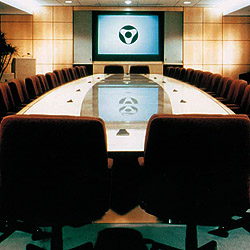
Audience
The desired sound source is a group of talkers. Undesired sound sources may include loudspeakers and various ambient sounds. The use of audience microphones is governed, to some extent, by the intended destination of the sound.
In general, high level sound reinforcement of the audience in a meeting facility is not recommended. In fact, it is impossible in most cases, unless the audience itself is acoustically isolated from the sound system loudspeakers.
Use of audience microphones to cover the same acoustic space as the sound system loudspeakers results in severe limitations on gain before feedback. The absolute best that can be done in this circumstance is very low level reinforcement in the immediate audience area, and medium level reinforcement to distant areas, such as balconies or foyers.
Destinations such as isolated listening areas, recording equipment, or broadcast audiences, can receive higher levels because feedback is not a factor in these locations.
A condenser is the type of microphone most often used for audience applications. They are generally more capable of flat, wide-range frequency response. The most appropriate directional type is a unidirectional pattern, usually a cardioid.
A supercardioid or a hypercardioid may be used for slightly greater ambient sound rejection.
Balanced low-impedance output must be used exclusively and the sensitivity should be high because of the greater distance between the source and the microphone. This higher sensitivity is also easier to obtain with a condenser design.
The physical design of a microphone for audience pickup should lend itself to some form of overhead mounting, typically hanging. It may be supported by its own cable or by some other mounting method.
Finally, it may be a full size microphone, or a miniature type for unobtrusive placement. A particular method that is sometimes suggested for overhead placement is a ceiling-mounted microphone, usually a boundary microphone. This position should be used with caution, for two reasons.
First, it often places the microphone too far from the desired sound source, especially in the case of a high ceiling. Second, the ceiling, in buildings of modern construction, is often an extremely noisy location, due to air handling noise, lighting fixtures, and building vibration.
Remember that a microphone does not reach out and capture sound. It only responds to the sound that has travelled to it. If the background noise is as loud or louder at the microphone than the sound from the talker below, there is no hope of picking up a usable sound from a ceiling-mounted microphone.
Placement of audience microphones falls into the category known as area coverage. Rather than one microphone per sound source, the object is to pick up multiple sound sources with one (or more) microphone(s).

